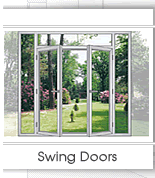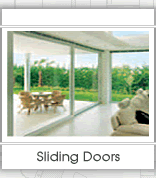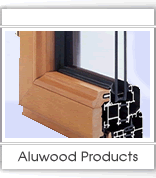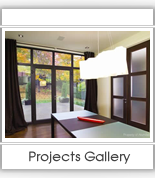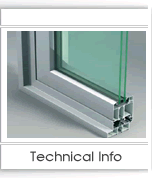|
TECHNICAL INFORMATION
Acoustical Glass
For today's design professional, selecting the right glass for commercial buildings can be a challenge. Many factors must be taken into account, such as meeting the original design concept, as well as solar, optical and acoustical performance requirements.
While glass is inherently a poor performer when considering its sound attenuating (sound transmission) characteristics, combinations of various glass types and acoustical window frames can effectively reduce sound transmissions.
Sound transmission through building walls and glass is related to the limp/mass law. Simply stated, the heavier, more flexible the material is, the better it will be at reducing sound transmission. Since glass is essentially lightweight and very stiff, it tends to transmit more sound than other building materials.
Acoustical Barriers
Sound transmission into a building may occur through many sources other than glass or windows. Consequently, another performance aspect to consider is the entire wall or building envelope.
While sound may be transmitted through many components of a building wall, this transmitted sound may be absorbed in varying degrees by other components within the wall and by the building itself. When sound waves strike a wall, a portion of this energy is reflected, transmitted or absorbed by the wall.
This distribution of sound energy varies as a function of the wall construction and its components. Porous materials within the wall, such as fiberglass, mineral wool and foam insulation, tend to absorb more of the sound energy. This is the result of the frictional drag of vibrating air molecules as they attempt to pass through the fibers or structure of the insulating materials-commonly referred to as sound damping. Sound damping may occur with the building interior, as well as furniture, wall and floor coverings.
Another condition that can occur in building wall construction is sound flanking. Flanking is the transmission of sound from one side of an acoustical barrier to the other through alternative routes-other than the acoustical barrier. For example, with an exterior wall there may be a number of alternative flanking paths that affect the performance of a wall. Some of these include water and steam pipes, HVAC ducts, electrical conduits, outlets, plumbing, drains, wall vents and openings (holes or cracks).
Glass as a Sound Barrier
Glass is inherently a "poor performer" when considering sound transmission characteristics. Fortunately, the glass used in building construction provides other substantial benefits. As a result, we tend to find ways to optimize the acoustical performance of glass for specific applications.
With any material, the sound transmission loss is dependent on its mass, stiffness and damping characteristics. With a single glass ply, the only effective way to increase its performance is to increase the thickness, because stiffness and damping cannot be changed. The sound transmission loss (STL) for a single glass ply, measured over 18 different frequencies, varies depending on glass thickness.
Thicker glass tends to provide greater sound reduction even though it may actually transmit more sound at specific frequencies. The critical frequencies may show improvements to sound transmission loss while the non critical frequencies actually transmit more sound. This is due to the three distinct regions in which glass reacts to sound: mass controlled, resonance controlled and stiffness controlled.
Within the resonance and stiffness regions, greater STL may be achieved by varying the glass thickness in multiple glass ply construction. In the mass region, an increase in weight is required.
In addition to the behavior of the glass within these regions, various glass thicknesses and constructions (laminated, insulating or a combination of each) have their own specific critical frequency at which they begin to vibrate. It is at this critical frequency where the greatest amount of sound transmission occurs.
By evaluating the STL of various tested products, one can optimize the glass performance by carefully selecting the product that provides the greatest STL at the range of frequencies most critical to the building application.
Commercial buildings use a wide variety of glass types, which may enhance solar control and safety performance. Monolithic glass plies will provide the lowest acoustical performance levels. Laminated glass can provide higher acoustical performance levels than monolithic glass due to the sound damping characteristics of the polyvinyl butyral (pvb) interlayer used to permanently bond the glass plies together. And, insulating glass tends to provide the highest STL potential of any glass product due to the versatility of the product and its ability to combine monolithic and laminated glass plies.
|

